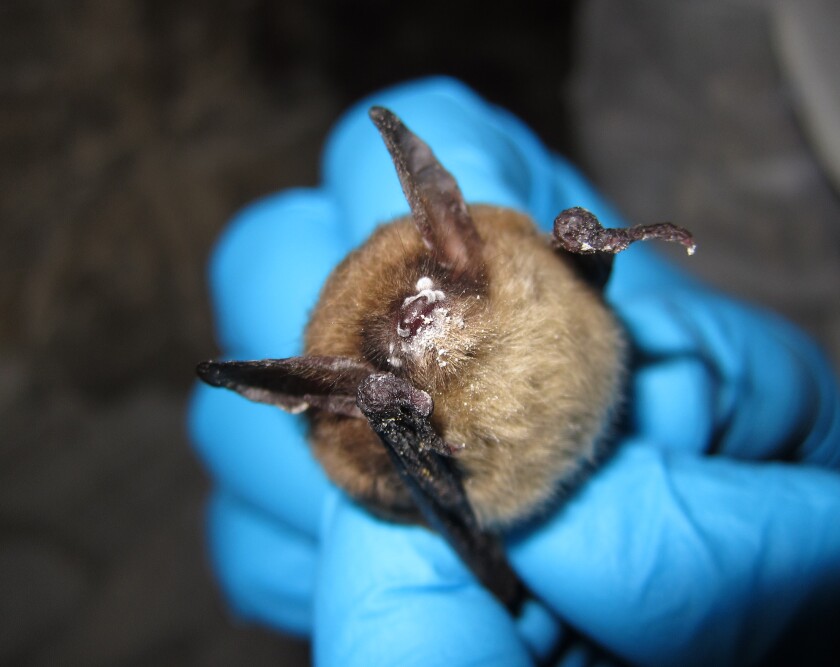WASHINGTON, D.C. — The northern long-eared bat, once common across Northland forests but which has been dying off rapidly due to an invasive fungus, was officially declared an endangered species Tuesday by the U.S. Fish and Wildlife Service.
The Biden administration made the move in a last-ditch effort to save the bats, which winter in caves and abandoned mines where they spread deadly white-nose syndrome among each other, such as in the Soudan Underground Mine near Tower.
ADVERTISEMENT
The disease causes the bats to overheat, become active when they should be hibernating and eventually starve and die. The fungus is almost always fatal and has wiped out entire hibernacula (winter shelters) and millions of bats since it was discovered in New York in 2006, including an estimated 96% of all northern long-eared bats.
The disease originated in Europe, where it doesn’t seem to impact bats.
The federal endangered status, which takes effect Jan. 30, is an upgrade from the protected status the bat has had since 2015. But wildlife officials concede there is little they can do except keep good habitat available for the few remaining northern long-eared bats and continue to look for some sort of cure.
In the Soudan mine, where thousands of northern long-eared bats were seen each winter when the Minnesota Department of Natural Resources would survey bats far below ground, not a single northern long-eared bat was counted last winter.
“This listing is an alarm bell and a call to action,” Martha Williams, U.S. Fish and Wildlife Service director, said in a statement announcing the action. “White-nose syndrome is decimating cave-dwelling bat species like the northern long-eared bat at unprecedented rates. The Service is deeply committed to working with partners on a balanced approach that reduces the impacts of disease and protects the survivors to recover northern long-eared bat populations.”

The disease has spread across nearly 80% of the geographic range where northern long-eared bats live and is expected to cover it all by 2025. Other species ravaged by the fungus include the tricolored bat, which the government proposed to classify as endangered in September, and the little brown bat.
Recovery efforts will focus on forested areas where the bats roost during the day in summer, usually in cavities in large, old trees. And it’s possible the endangered status could impact some timber cutting on federal lands such as the Superior, Chequamegon and Chippewa national forests.
ADVERTISEMENT
Under the Endangered Species Act, federal agencies are required to consult with the Fish and Wildlife Service to be sure projects that they fund or authorize, such as tree cutting, prescribed fires and highway construction, will not jeopardize the bat further. For non-federal landowners, such as the state and counties, actions that could result in unintentional kills could be allowed but will require permits.
The agency said that it will also work with wind energy companies to reduce the likelihood that bats will strike turbines. These collisions are currently a threat in roughly half of the northern long-eared bat's range, an area likely to grow as wind energy development expands.
Research continues for methods to fight white-nose syndrome, including development of a vaccine. The federal agency had dolled out some $46 million for the effort that includes nearly 150 agencies, universities, private groups and Indigenous tribes.
Bats are critical to healthy, functioning natural areas and contribute at least $3 billion annually to the U.S. agriculture economy through pest control and pollination. The northern long-eared bat is found in 37 states in the eastern and north central United States, the District of Columbia, and all Canadian provinces from the Atlantic Coast west to the southern Northwest Territories and eastern British Columbia.
White-nose syndrome is caused by the growth of a fungus that sometimes looks like white fuzz on bats’ muzzles and wings. The fungus thrives in cold, dark, damp places and infects bats during hibernation. Impacted bats wake up more frequently, which often results in dehydration and starvation before spring arrives.
Bats are the only species of wildlife known to be affected by white-nose syndrome, which has been confirmed in 38 states, including Minnesota and Wisconsin, and eight Canadian provinces.










